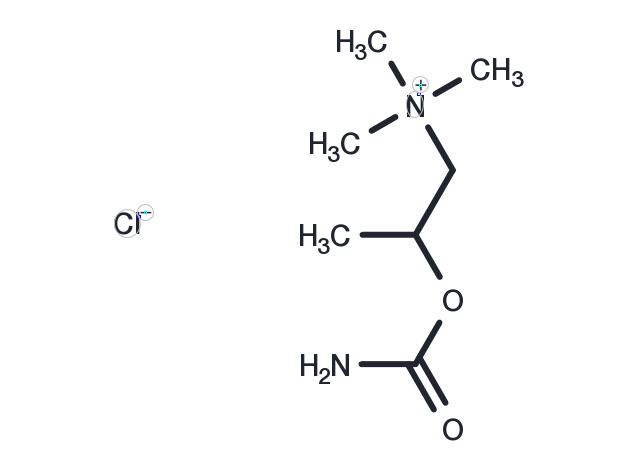keep away from direct sunlight
Powder: -20°C for 3 years | In solvent: -80°C for 1 year

Bethanechol chloride (Carbamyl-β-methylcholine chloride) is a slowly hydrolyzing muscarinic agonist with no nicotinic effects. Bethanechol is generally used to increase smooth muscle tone, as in the GI tract following abdominal surgery or in urinary retention in the absence of obstruction. It may cause hypotension, heart rate changes, and bronchial spasm.

| Pack Size | Availability | Price/USD | Quantity |
|---|---|---|---|
| 500 mg | In stock | $ 30.00 | |
| 1 g | In stock | $ 37.00 | |
| 1 mL * 10 mM (in DMSO) | In stock | $ 29.00 |




| Description | Bethanechol chloride (Carbamyl-β-methylcholine chloride) is a slowly hydrolyzing muscarinic agonist with no nicotinic effects. Bethanechol is generally used to increase smooth muscle tone, as in the GI tract following abdominal surgery or in urinary retention in the absence of obstruction. It may cause hypotension, heart rate changes, and bronchial spasm. |
| Synonyms | (±)-Bethanechol, Urecholine, Myocholine, Carbamyl-β-methylcholine chloride |
| Molecular Weight | 196.68 |
| Formula | C7H17N2O2·Cl |
| CAS No. | 590-63-6 |
keep away from direct sunlight
Powder: -20°C for 3 years | In solvent: -80°C for 1 year
H2O: 36 mg/mL (183 mM)
DMSO: 37 mg/mL (188.1 mM)
Ethanol: 37 mg/mL (188.1 mM)
You can also refer to dose conversion for different animals. More
bottom
Please see Inhibitor Handling Instructions for more frequently ask questions. Topics include: how to prepare stock solutions, how to store products, and cautions on cell-based assays & animal experiments, etc.
Bethanechol chloride 590-63-6 Neuroscience AChR (±)-Bethanechol Urecholine Myocholine inhibit parasympathomimetic retention Carbamyl-beta-methylcholine Chloride parasympathetic Bethanechol receptors urinary ,retention Inhibitor postoperative Carbamyl-β-methylcholine Chloride Muscarinic acetylcholine receptor Carbamyl-β-methylcholine chloride postpartum incontinence overflow mAChR Carbamyl-b-methylcholine Chloride Bethanechol Chloride urinary inhibitor
